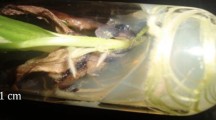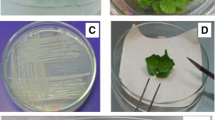Abstract
Hairy roots of Nasturtium officinale, Barbarea verna and Arabis caucasica with active glucosinolate-myrosinase system were obtained after transformation with Agrobacterium rhizogenes. Hairy roots of N. officinale produced phenylalanine-derived gluconasturtiin and glucotropaeolin (max. 24 and 7 mg g−1 DW). B. verna and A. caucasica hairy roots produced gluconasturtiin (max. 41 mg g−1 DW) and methionine-derived glucoiberverin (max. 32 mg g−1 DW), respectively. Treatment of the roots with amino acid precursors of glucosinolate or/and cysteine biosynthesis increased levels of glucosinolate production, combinations of phenylalanine with cysteine (for gluconasturtiin and glucotropaeolin) and methionine with o-acetylserine (for glucoiberverin) were the most effective.




Similar content being viewed by others
References
Aoyama T, Hirayama T, Tamamoto S, Oka A (1989) Putative start codon TTG for the regulatory protein VirG of the hairy-root-inducing plasmid pRiA4. Gene 78:173–178
Campos de Quiros H, Magrath R, McCallum D, Kroymann J, Scnabelrauch D, Mithell-Olds T, Mithen R (2000) α-Keto acid elongation and glucosinolate biosynthesis in Arabidopsis thaliana. Theor Appl Genet 101:429–437
Du L, Halkier BA (1996) Isolation of microsomal enzyme system involved in glucosinolate biosynthesis from seedlings of Tropaeolum majus L. Plant Physiol 111:831–837
Fahey JW, Zalcmann AT, Talalay P (2001) The chemical diversity and distribution of glucosinolates and isothiocyanates among plants. Phytochemistry 56:5–51
Gamborg OL, Miller RA, Ojima K (1968) Nutrient requirements of suspension cultures of soybean root cells. Exp Cell Res 50:151–158
Hayes JD, Kelleher MO, Eggleston IM (2008) The cancer chemopreventive actions of phytochemicals derived from glucosinolates. Eur J Nutr 47:73–88
Królicka A, Staniszewska I, Bielawski K, Maliński E, Szafranek J, Łojkowska E (2001) Establishment of hairy root cultures of Ammi majus. Plant Sci 160:259–264
Pirtillä AM, Hirsikorpi M, Kämäräinen T, Jaakola L, Hohtola A (2001) DNA isolation methods for medicinal and aromatic plants. Plant Mol Biol Rep 19:273a–273f
Songsak T, Lockwood GB (2004) Production of two volatile glucosinolate hydrolysis compounds in Nasturtium montanum and Cleome chelidonii plant cell cultures. Fitoterapia 75:296–301
Sultana T, Savage GP, McNeil DL, Porter NG, Martin RJ, Deo B (2002) Effects of fertilization on the allyl isothiocyanate profile of above-ground tissues of New Zealand-grown wasabi. J Sci Food Agric 82:1477–1482
Wallsgrove RM, Bennett RN, Doughty K (1999) Glucosinolates. In: Singh BK (ed) Plant amino acids: biochemistry and biotechnology. Marcel Dekker, New York, pp 523–562
Wielanek M, Urbanek H (2006) Enhanced glucotropaeolin production in hairy root cultures of Tropaeolum majus L. by combining elicitation and precursor feeding. Plant Cell Tissue Organ Cult 86:177–186
Wirtz M, Droux M (2005) Synthesis of the sulfur amino acids: cysteine and methionine. Photosynth Res 86:345–362
Acknowledgements
This work was partly supported by The State Committee for Scientific Research Grant No. 2P04C 003 2 and by University of Łódź Grant No. 506/819.
Author information
Authors and Affiliations
Corresponding author
Rights and permissions
About this article
Cite this article
Wielanek, M., Królicka, A., Bergier, K. et al. Transformation of Nasturtium officinale, Barbarea verna and Arabis caucasica for hairy roots and glucosinolate-myrosinase system production. Biotechnol Lett 31, 917–921 (2009). https://doi.org/10.1007/s10529-009-9953-0
Received:
Accepted:
Published:
Issue Date:
DOI: https://doi.org/10.1007/s10529-009-9953-0




